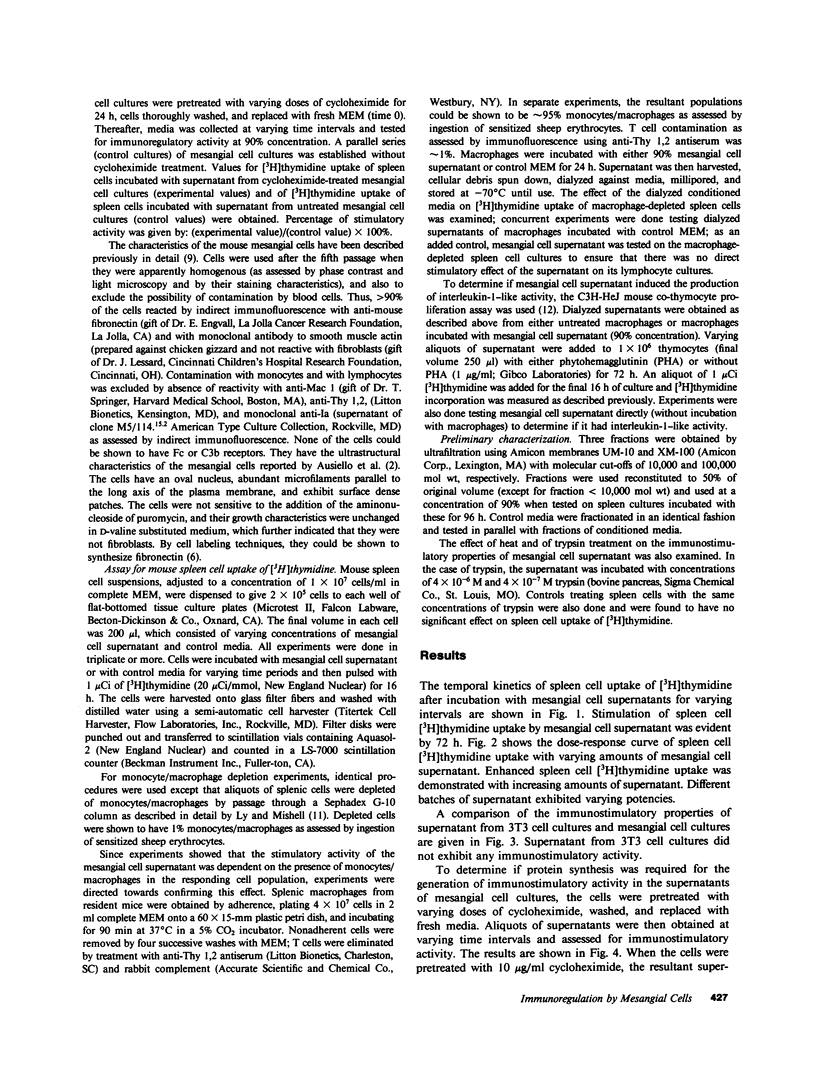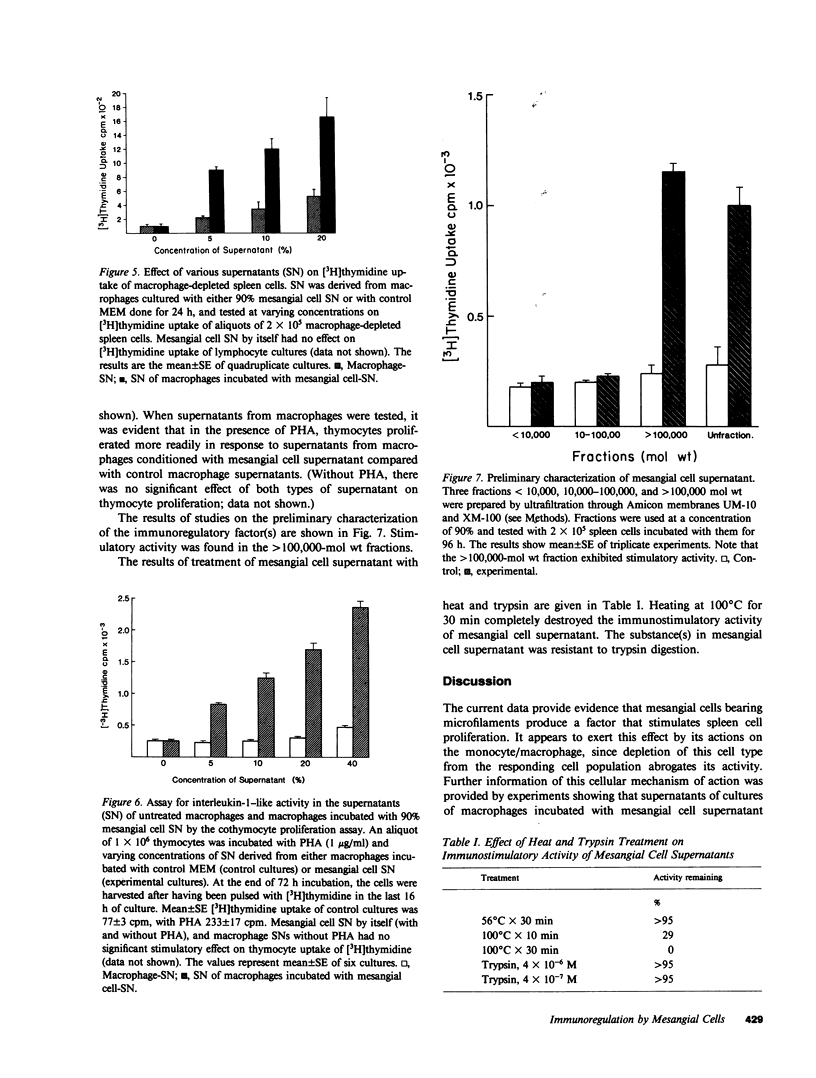Abstract
The functions of the glomerular mesangium are served by at least two populations of cells--a cell bearing microfilaments that regulates blood flow, and a phagocytic cell bearing Ia determinants and Fc receptors. We provide evidence that mouse mesangial cells (bearing microfilaments) produce a factor(s) that stimulates spleen cell proliferation. The factor(s) appears to act via monocytes/macrophages, since its stimulatory activity is abrogated by prior depletion of the responding mononuclear cell population of monocytes/macrophages. Confirmation of its action on macrophages was documented by experiments that showed that medium from macrophages incubated with mesangial cell supernatant contained greater amounts of a factor that stimulated [3H]thymidine uptake by macrophage-depleted spleen cell populations. By the cothymocyte proliferation assay, it could be shown that mesangial cell supernatant induced splenic macrophage production of interleukin-1-like activity. Preliminary characterization reveals the factor to have a molecular weight greater than 100,000. Thus, a novel function is delineated for this mesangial cell type that appears capable of modulating the local immune response by providing an amplification signal.
Full text
PDF




Selected References
These references are in PubMed. This may not be the complete list of references from this article.
- Ausiello D. A., Kreisberg J. I., Roy C., Karnovsky M. J. Contraction of cultured rat glomerular cells of apparent mesangial origin after stimulation with angiotensin II and arginine vasopressin. J Clin Invest. 1980 Mar;65(3):754–760. doi: 10.1172/JCI109723. [DOI] [PMC free article] [PubMed] [Google Scholar]
- Barcelli U., Rademacher R., Ooi Y. M., Ooi B. S. Modification of glomerular immune complex deposition in mice by activation of the reticuloendothelial system. J Clin Invest. 1981 Jan;67(1):20–27. doi: 10.1172/JCI110013. [DOI] [PMC free article] [PubMed] [Google Scholar]
- Booth R. J., Watson J. D. Interleukin 1 induces proliferation in two distinct B cell subpopulations responsive to two different murine B cell growth factors. J Immunol. 1984 Sep;133(3):1346–1349. [PubMed] [Google Scholar]
- Foidart J., Sraer J., Delarue F., Mahieu P., Ardaillou R. Evidence for mesangial glomerular receptors for angiotensin II linked to mesangial cell contractility. FEBS Lett. 1980 Dec 1;121(2):333–339. doi: 10.1016/0014-5793(80)80375-9. [DOI] [PubMed] [Google Scholar]
- Holdsworth S. R., Neale T. J., Wilson C. B. Abrogation of macrophage-dependent injury in experimental glomerulonephritis in the rabbit. Use of an antimacrophage serum. J Clin Invest. 1981 Sep;68(3):686–698. doi: 10.1172/JCI110304. [DOI] [PMC free article] [PubMed] [Google Scholar]
- Hunsicker L. G., Shearer T. P., Plattner S. B., Weisenburger D. The role of monocytes in serum sickness nephritis. J Exp Med. 1979 Sep 19;150(3):413–425. doi: 10.1084/jem.150.3.413. [DOI] [PMC free article] [PubMed] [Google Scholar]
- Kreisberg J. I., Karnovsky M. J., Levine L. Prostaglandin production by homogeneous cultures of rat glomerular epithelial and mesangial cells. Kidney Int. 1982 Oct;22(4):355–359. doi: 10.1038/ki.1982.181. [DOI] [PubMed] [Google Scholar]
- Lovett D. H., Ryan J. L., Sterzel R. B. A thymocyte-activating factor derived from glomerular mesangial cells. J Immunol. 1983 Apr;130(4):1796–1801. [PubMed] [Google Scholar]
- Lovett D. H., Sterzel R. B., Kashgarian M., Ryan J. L. Neutral proteinase activity produced in vitro by cells of the glomerular mesangium. Kidney Int. 1983 Feb;23(2):342–349. doi: 10.1038/ki.1983.25. [DOI] [PubMed] [Google Scholar]
- Ly I. A., Mishell R. I. Separation of mouse spleen cells by passage through columns of sephadex G-10. J Immunol Methods. 1974 Aug;5(3):239–247. doi: 10.1016/0022-1759(74)90108-2. [DOI] [PubMed] [Google Scholar]
- Michael A. F., Keane W. F., Raij L., Vernier R. L., Mauer S. M. The glomerular mesangium. Kidney Int. 1980 Feb;17(2):141–154. doi: 10.1038/ki.1980.18. [DOI] [PubMed] [Google Scholar]
- Mizel S. B. Interleukin 1 and T cell activation. Immunol Rev. 1982;63:51–72. doi: 10.1111/j.1600-065x.1982.tb00411.x. [DOI] [PubMed] [Google Scholar]
- Ooi Y. M., Weiss M. A., Hsu A., Ooi B. S. Mechanisms of suppression of mouse mesangial cell proliferation by macrophage supernatants. J Immunol. 1983 Apr;130(4):1790–1795. [PubMed] [Google Scholar]
- Schreiner G. F., Cotran R. S., Pardo V., Unanue E. R. A mononuclear cell component in experimental immunological glomerulonephritis. J Exp Med. 1978 Feb 1;147(2):369–384. doi: 10.1084/jem.147.2.369. [DOI] [PMC free article] [PubMed] [Google Scholar]
- Schreiner G. F., Kiely J. M., Cotran R. S., Unanue E. R. Characterization of resident glomerular cells in the rat expressing Ia determinants and manifesting genetically restricted interactions with lymphocytes. J Clin Invest. 1981 Oct;68(4):920–931. doi: 10.1172/JCI110347. [DOI] [PMC free article] [PubMed] [Google Scholar]
- Sraer J., Foidart J., Chansel D., Mahieu P., Kouznetzova B., Ardaillou R. Prostaglandin synthesis by mesangial and epithelial glomerular cultured cells. FEBS Lett. 1979 Aug 15;104(2):420–424. doi: 10.1016/0014-5793(79)80866-2. [DOI] [PubMed] [Google Scholar]
- Unanue E. R. The regulatory role of macrophages in antigenic stimulation. Part Two: symbiotic relationship between lymphocytes and macrophages. Adv Immunol. 1981;31:1–136. doi: 10.1016/s0065-2776(08)60919-0. [DOI] [PubMed] [Google Scholar]


